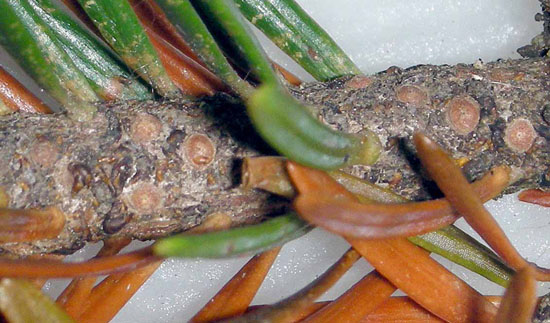Issue 13, July 31, 2009
Lantania Scale
Lantania scale, Hemiberlesia lataniae, occurs on a wide range of plants and is more common in the southern U.S. where it feeds heaviest on Australian pine (Casuarina), loquat, rose, and various palms. However, it feeds on a wide range of other trees and shrubs except for oaks and some conifers. We recently received a declining balsam fir with a heavy infestation, and it has been found on other Illinois hosts in the past. Being an armored scale, honeydew is not produced.

Lantania scale is a small, circular scale, about one-sixteenth inch in diameter. It varies in color, tending to be light gray to white on leaves and smooth stems but gray to brown on older stems and branches. On older stems and branches, there is a light to dark brown nipple made of the cast skins of younger nymphal stages. Male scales are oval with the shed skins offset from center. Both the females under the scale covers and the crawlers are yellow. With their small size and cryptic coloration, it is easy to overlook even heavy infestations.
In Maryland, this scale has two generations per year with first generation crawlers appearing from mid-June to mid-July and second generation crawlers appearing in September. In Egypt and Israel, there are two to four generations per year. The Illinois fir specimen inspected during the last week of July was in the egg stage, making crawlers likely to appear in August. Nymphs overwinter in Maryland. That is probably the case in Illinois as well because the life cycle takes a couple of months of warm temperatures to complete.
Overwintering as nymphs should make them susceptible to dormant oil spray. Crawler sprays in August of insecticidal soap, summer spray oil, pyrethroids, or other labeled insecticides should be effective. Be sure to scout for crawler presence before treating.--Phil Nixon
Author:
Phil Nixon